Trending
Opinion: How will Project 2025 impact game developers?
The Heritage Foundation's manifesto for the possible next administration could do great harm to many, including large portions of the game development community.

Featured Blog | This community-written post highlights the best of what the game industry has to offer. Read more like it on the Game Developer Blogs or learn how to Submit Your Own Blog Post
I just returned from a successful GenCon 2016 with pre-order sales exceeding my expectations. Here is what worked, what didn’t, why, and lessons learned. Learn why the economic theories of Lemons and Signaling matter to indie game devs.


Archmage Rises is a role-playing game set inside a living breathing simulated open world. We were greenlit in 10 days.
I just returned from GenCon 2016 (turnstile count 201,852, uniques 60,819) where I demoed Archmage Rises to the public for the first time. It was the first time I took pre-orders for the game. I had no idea what would happen. Overall the Con was extremely successful for us and exceeded my revenue expectations. Here is what worked, what didn’t, why, and lessons learned.
In The Inner Lives of Markets the authors explain why a 1970 paper by economist George Akerlof influences almost all purchase decisions made today between strangers. Whether it is through the Internet, or in person at a Con, you are dealing with complete strangers.
 Akerlof’s paper "The Market for Lemons: Quality Uncertainty and the Market Mechanism" is about information asymmetry between buyers and sellers. He illustrates the theory with the used car market: the previous owner of a vehicle knows if the car was driven and maintained well or not. The buyer has no access to this information, and even if asked, cannot be certain the answer is truthful. No buyer of a used car wants to buy a “lemon” (a car found to be defective just after purchase). Therefore, if a buyer is willing to pay $5,000 for a good quality used car but a lemon is only worth $1,000, and the buyer cannot easily tell the difference between them, buyers will only pay $1,000 for any used car. If they luck out with a good one, great. If not, they didn’t overpay. But even with all cars at $1,000 some lemon cars are better than others, so buyers will now only be willing to pay $500 for a really bad lemon.
Akerlof’s paper "The Market for Lemons: Quality Uncertainty and the Market Mechanism" is about information asymmetry between buyers and sellers. He illustrates the theory with the used car market: the previous owner of a vehicle knows if the car was driven and maintained well or not. The buyer has no access to this information, and even if asked, cannot be certain the answer is truthful. No buyer of a used car wants to buy a “lemon” (a car found to be defective just after purchase). Therefore, if a buyer is willing to pay $5,000 for a good quality used car but a lemon is only worth $1,000, and the buyer cannot easily tell the difference between them, buyers will only pay $1,000 for any used car. If they luck out with a good one, great. If not, they didn’t overpay. But even with all cars at $1,000 some lemon cars are better than others, so buyers will now only be willing to pay $500 for a really bad lemon.
The market unravels with a race to the bottom ($0).
No one with a good used car will ever sell it as the sell value is too low (better to just keep driving until it becomes a lemon) and no buyer will ever buy a used car because the market is primarily lemons.
Ironically, these forces describe exactly what caused the video game crash of 1983.
Gone are the days where every game has the Nintendo seal of quality on it. :-)

The indie game market is just as subject to these forces as used cars or cartridges. With no proven track record (brand) few gems (FTL, Stardew Valley, Gone Home, etc.) and many “lemons” (I won’t name names) buyers are wary. We saw mobile game prices quickly tumble to $1 or free. Steam games started to follow a similar path.
The solution to this dilemma is found in the economic theory of Signaling. An employer is unable to tell if any specific person will or will not be a good employee until after they are hired. So the employee uses an external system (educational credentials) to signal to the employer their quality. A degree from an ivy league school is rarer, requires more investment, and thought harder to attain, so it is concluded an employee with an ivy league education is less likely to be a “lemon”. Both the employee and employer look to a third party for “signals” of quality that are not easily duplicated. Public key encryption works similarly.
eBay uses seller rating. Amazon uses product reviews. Steam uses player reviews.
There are two things under your control for successful signaling: You and Your Booth

One of the most important decisions you will make is done before you even step foot in the Con space.
If a quality used car sells for $5,000 and a lemon sells for $1,000 and I price my car at $1,500 what signal am I sending?
Apple sends a signal by how they price their laptops, phones, and tablets.
The first person to evaluate the quality of your game is you! the price you set is an indication to the world as to what you think of your game.
High quality AAA games sell for around $50-70 USD. If you are close to that number, you are saying something. If you are close to the price of a chocolate bar, stick of gum, or a song on iTunes, you are also saying something.
My survey of indie games results in a range from $10-$40. $40 seems to be the “III” studios like Paradox Interactive, Stardock, while $10-15 is the low end typically single developers.
I set Archmage Rises at 29.99 USD to signal the statement that I want to make: it is twice as good as a $15 game! :-)
I am in the 20’s indie price zone; yet at the top end of it. Once you set a price, that is your top end. You’ll be reducing (sales, specials, offers, etc.) from there on. So give yourself some room to maneuver.
Setting the price at $30 lets me discount it by $10 (33%) and still get $20.
When at a Con you need a call to action. A reason for them to buy RIGHT NOW from you. Not to think about it and do it later. Which by the way, rarely ever happens! Saving $10 is a compelling enough reason not to wait. The likelihood of getting a $10 discount post-release is low, you’d probably have to wait 6+ months for a steam sale.
Several people asked me at the booth “You are only asking for $20? Sure, why not.” Which is exactly the sentiment I was hoping for. This told me I was priced within the right range.
Finally, when I launch on Steam if I do a launch discount of 20% (I personally don’t find 10% compelling) I’m still getting $24 per unit. Had I started at $25 and offered 20% off, it is only $20. That extra $4,000 per thousand units (minus store fees) could be the difference between profit and looking for a new job.
Note: I am focusing purely on the signaling aspect your price point broadcasts. There is more to pricing strategy than I am describing here and you should read what more knowledgeable people say on the subject.
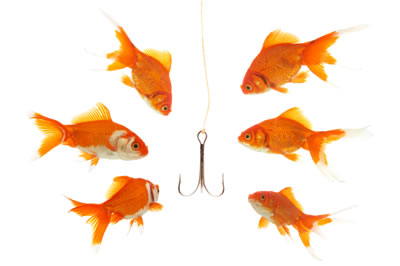
Archmage Rises isn’t for everyone. It doesn’t have the fancy 3d run-around graphics of mainstream games. It’s a thoughtful game with deep immersive gameplay that works with the player’s imagination. The player has more freedom of action than any other RPG before it. We also have some very “board game-y” elements in the game, like a hex map and Event Cards that appear when you trigger a trap in a dungeon.
So who would like a 2d text-heavy thinking role playing game set in a simulated world? Tabletop role players!
The biggest gathering of tabletop RPGers in North America is GenCon in Indianapolis. This is where I determined to go. I applied for 2015 and was turned down. With my second attempt I was approved in Jan 2016. I had 8 months to turn a wish into an effective booth.
Not all Cons are the same. I’ve been to GDC. I believe that is a show & tell Con. GenCon is for players who are buying! Having attended twice previously, I knew part of the attendee preparation is bringing a fat wad of cash into the exhibit hall. Some even bring empty suitcases to carry their loot. Why? The thrill is in discovering a new game and walking away with it today. Each night the hotel lobbies (and hallways, and coffee shops) are chock full of gamers playing their latest purchases.
It was impossible for me to keep count (I tried), but I think I talked with about 1,000 people over the course of the 4 days.
99% of them liked both tabletop and computer role playing games. I remember one person who said they don’t play RPGs very much. We didn’t have much to talk about. :-) There may have been a second person.
99% of them like board games.
99% of them knew of or played Pathfinder (it helped Paizo had one of the biggest booths there). That our artist works on both Pathfinder and Archmage Rises simultaneously is helpful.
80% of them knew of Dragonlance and Raistlin (the fictional character that inspired the game)
75% of them were over 30 balancing work and family. They appreciate a character lifetime can be done in around 4 hours.
All of the above describes my core-core market. I think about them every day as I design and program. It’s not hard, because all the above describes me too. :-)
Overall this led to an extremely receptive audience to the game. Because I chose the right Con, virtually anyone walking by the booth was a potential customer. Here is just one example from the last day that proves this:
A man was walking briskly past our booth looking for something (not us!). He had a chainmail coif on his head (why not!) He wasn’t cos playing, the rest of him was street clothes. The chainmail started silver on top then changed color to be red and yellow down near his shoulders. No one was in our booth at that moment, so just as he was about past I said “Hey, nice hat!”. He stopped and turned to me and explained a little bit about it. He then asked what we were about. I gave him the 2 min pitch and he pre-ordered on the spot.
When that happened it made me realize I should have engaged more people that were just walking by instead of waiting for them to stick on something first.
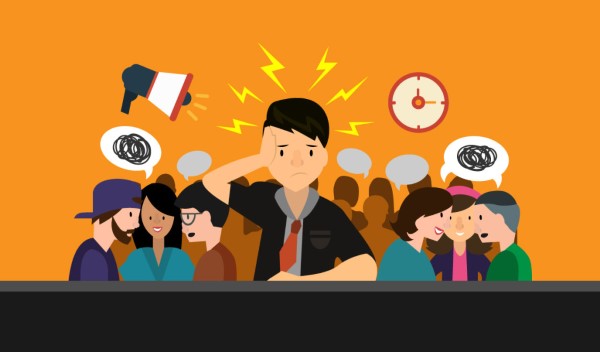
I’m an introvert. I type this article in a solitary room alone with my thoughts. It’s heaven.
The lights, noise, and crowds of a massive Con is hell. Or purgatory: something to be endured until it ends and I gain a huge reward.
I think there is a general misunderstanding of the terms Introvert/Extravert, so let me define them:
An introvert is someone who loses energy when with others, and regains it when alone.
An extravert is someone who gains energy when with others, and loses it when alone.
That’s it. I’ve heard people use the term to mean shyness, or being reserved, or someone who doesn’t like meeting strangers. I even heard a famous public speaker talk about how he got over his introverted-ness. You don’t “get over it”. It’s part of your personality make up, how you deplete or restore your soul.
Making a game involves thousands of hours sitting at a computer either coding, designing, or drawing. It is a profession that introverts gravitate towards because the alone time isn’t draining, it’s refreshing. A friend of mine, an extravert, runs a landscaping business because A) he can’t stand being indoors and B) he has to talk to someone every 20 minutes. Sitting at a computer for 8 hours a day with no one to talk to is hell for him.
I expect most indie game devs are introverts like me. The grueling technical work of making a game weeds out the extraverts who need to see and talk with someone every 20 minutes.
My first full time job was as a pure commission computer sales person at a Circuit City like retailer. I got the job because of my extensive computer knowledge. I met between 30-50 new people a day and it almost killed me. Nowhere to hide and recharge during the day, I just had to figure out a way to endure it. I had to learn how to be outgoing, boisterous, charming, quick thinking, and friendly whether I felt like it or not.
Over 2 years, learn it I did! I became one of the top sales people in the area. I figured out how to “turn it on”, like an actor who “gets into character”. Like a gamer role-playing a character.

Ah, so maybe the idea of pretending to be someone you are not for a while isn’t so foreign to introverts after all!
Here are some tips on how to role-play as a smooth talking extravert (I like to think of Harvey Specter from Suits):

Each morning, when I woke up at 8:11am (2hrs earlier than my usual) I needed to motivate myself to stand in a booth for 9 hours. Meeting a constant stream of strangers. Remembering the goal is highly motivating. I want the end result: media for the game, pre-orders, people to be aware of it. Knowing that the temporary difficult task is helping me meet my overall lifetime goals helps a lot.
When I cycle up extremely steep hills, already in the fastest possible gear, the question is not “can I get up the hill?” it is “Can my legs make one more revolution?” The answer is always yes: I don’t want to, but I can make one more revolution. String enough of those together and I’m at the top of the hill.
I don’t want to talk to anyone in the booth for the rest of the day. But can I talk to just one more person about how awesome Archmage Rises is? Yes. I can do one more.
Pretty soon, you’re at the end of the day engaging 100 more people than you thought you could.
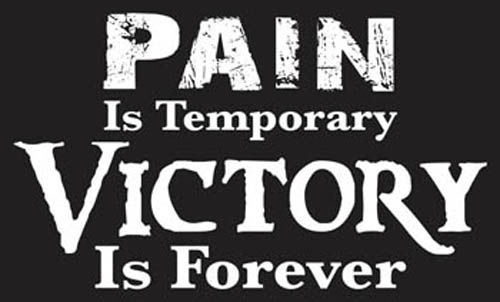
It’s 2pm, I’m exhausted and going hoarse. Four more hours to go to the end of the day. I just want to leave my 10 foot by 10 foot “prison”. I don’t have a boss telling me not to, I work for myself. What to do?
Creative Visualization can help. Thinking about the book I will read tonight. Or the restaurant I will go to for dinner. Or next week when I’ll be home surrounded by quiet.
It sounds wacky, but it’s actually a regular part of life. It’s called “hope”. Sure you can’t read a good book right now, but the hope of doing it later can pull you through.
You may not like the whole meal, but some of the dishes might be pretty good.
I usually find once I am talking with someone I get caught up in the conversation. I’ll be clear, I love talking about the game I’ve poured 3+ years into. And the person on the receiving end actually understands what I’m saying (as opposed to my wife)! That’s awesome!
Another highlight for me is the Close. I may not want to shake someone’s hand and introduce myself and give the same 2-minute spiel I’ve given a thousand times before, but when they buy, boy oh boy does that feel good. It’s not even about the money. Frankly, I could care less about it. It’s more like golf or baseball when you have a good swing that makes excellent contact. It’s the achievement of something difficult that feels good.
So think about what aspects you DO enjoy about pitching your game. Maybe it is just meeting other people that like the same kinds of games you do, or finding others who have read similar books, or seeing that moment of wonder in their eyes when they “get it”.
Remember, it’s not all bad!
Humans like to think they are totally rational, but that belief is irrational. :-)
I’ve seen game devs at their booth sitting in a folding chair looking away so as not to make eye contact with anyone passing by. Or another way to hide is to just start playing their own game demo, repeatedly.
If you don’t want to talk to people about your game why are you at the Con?
Sounds like a silly question but I’ve seen the people who haven’t thought it through.
They operate on some misguided belief that if they show up at the Con people will just walk up, start playing, love it, and order it without a word exchanged. The game will sell itself. They can give themselves a gold star for being a good little game developer who demoed at a Con like you are supposed to.
That’s as misguided as thinking you can upload your game to the App store and millions will find it and love it. Millions, including me, have proven that narrative false. Yet when we do hear a story like it (Flappy Bird) we love it because it confirms this, our favorite narrative.
To spend significant money (costs are detailed later) and the travel time, all to be there, in that moment, and then not talk to anyone? That is the most foolish business decision I could make.
Thinking it through “Well, I’m here, might as well try” helps me break through the fear and discomfort.
Having been in sales 12 years, I wrote an article here on gamasutra condensing that experience into 12 principles on how to pitch. Two years later I still get twitter traffic about it. So I should arrive at a Con with a good pitch, right?
Oops.
When I was at GDC and someone asked me what I was working on, I’d say “It’s like a cross between FTL and Dwarf Fortress” or “a cross between FTL and Skyrim”. That served me well in a game developer context. But if you haven’t played those games, I’m talking nonsense.
For example, out of the hundred or so people I tried asking, not a single one had ever played FTL. FTL as a cornerstone of my pitch was a boat anchor dragging the whole thing down.

I wasn’t at a gamedev Con, I was at a tabletop player Con. I needed a pitch that was player oriented. Something that would resonate with a Pathfinder or D&D tabletop player who may or may not play much on the computer.
I also thought I was good to go because I had painstakingly crafted the Steam page description. The first thing it boldly says is “An RPG set in a World Simulator”. That reads pretty well, and the rest of the page launches from those two major points. But in speaking actually saying “set in a World Simulator” just turns to mush.
Writers know you use different words in dialogue than you do in narrative/exposition, that’s what makes it sound like someone speaking. I was armed with exposition and about to engage in dialogue. Doh!
When the first person walked up to the booth I was a gong show:
Them: “What’s this?”
Me: “It’s uh… a mage simulator which… uh the world’s first! It’s, like, an RPG but it is inside, ya-ya, set inside a world simulator.”
Blank stare.
“So you do… stuff. It’s really free and open. Did I mention you can own a business? Ya you can. You can, like, buy an inn in a town. Oh, and procedural generation. Ya, it’s procedural so the game is always different at the beginning. Well it’s different all the time too. So it’s really open. Did I mention you can buy an Inn?”
Are you surprised I didn’t get a pre-order? Me neither. Nobody wants to buy from that guy.
Here is what a good Con pitch needs:
Hook
Differentiator
The Why
The Wow
Call to Action
Close
A good pitch is 3-5 minutes long. That is enough time to get in, build rapport, hit the Wow, and ask for the close. If the person isn’t interested, you are not tied up for long and can move on to the next person. And at a big Con, there is always another person just waiting to talk to you.

In as short as possible (1-2 sentences), in as simple of language as possible, summarize how your game is unique.
In Star Trek they show the ship orbiting a planet or a beautiful matt painting of the city for 2 seconds before cutting to the characters talking or doing things. Why?
It’s called an “establishing shot” to quickly give the audience context. It helps the audience track WHERE we are in the story. And that is what your hook does.
At GenCon it is not even assumed that I’m selling a game. It could be mapping software, or virtual tabletop, or a campaign management system.
After hundreds of pitches I found this hook worked best:
“Archmage Rises is a role-playing game set inside a living breathing simulated open world.”
If I paused there, they would usually say something like “Interesting” or “tell me more” or “how does that work?”. Those kinds of reactions tell you your hook is working.
Now that they are listening, and looking me in the eye, I need to quickly and concisely tell them what is so special about this game. Why they should stay instead of going to another booth 10 feet away.
After refinement, I found this resonated well:
“The passage of time is really important, your character ages and so does the world. This means while you play NPC’s will die, towns will grow or shrink, quests will come and go. Because it’s a simulator, the world reacts realistically to your choices or inaction.”

I’ve just made some crazy bold claims to the audience. I need to support/substantiate what I’ve just said or risk losing them. I need to answer why they should believe a word I say.
I cleverly (or accidentally, I’ll never tell!) interwove my personal story into The Why:
“I’ve been a software developer for about 20 years. When I started this project I had a choice to make: either spend all my time and resources trying to match the 3d graphics of mainstream games, or put all my time into making a realistic simulated world that allows the player more freedom than any other cRPG. I’ve been working on the game for three and a half years. The first three years were just on the world generation and simulation. The unique terrain, the creation of towns, the NPC’s within the towns, even the stores, the inventory they have, the history of the world: what mages lived in the past, when, what gear did they have, what books did they write. All of that stuff becomes loot in the world you can find or buy. Every time you start the game you get an entirely new world to play in.”
My why contains the following reasons they should believe me:
I’ve been programming a long time, chances are pretty good I know how to program stuff
I’ve been working on it for 3+ years, so I’m clearly sticking with it and likely not to flake out
A simulated world is at least theoretically a possible way to allow a new kind of RPG experience
But it also carries a cleverly hidden inoculation against a common objection. Do you see it?
In a post WoW/Skyrim/Dragon Age world everyone associates RPG with “run around on a map”. Archmage Rises has a map, but you don’t drive around a 3d representation of yourself in the world. So my explanation of this goes from the person thinking “He’s lazy/cheap/amateur, where are the 3d graphics?” to “wow, he’s clever not to bother trying to compete on that front”.

With the context established and the scaffolding of a why in place to support it, the next part is to tell the audience something about the game that amazes them and makes them want it. You want to light off a mini-nuke in their imagination and blow their mind.
There are many ways to tell when you’ve hit “the wow”. They could laugh and literally say “wow”, or whistle, or emphatically say “No way!” or “Ooooh! I’ve always wanted to do that!” They will change body language dramatically. Their eyes will sparkle. They will turn to their friend/wife/partner and say something extremely positive.
You only have to do this once. Beginners will see the positive reaction and just start riding it by piling more and more “Wow” on top, subconsciously thinking that if one Wow is good, 23 is 23x better!
Pancakes are awesome with butter and maple syrup. They are also awesome with whip cream and fruit.

But if you pile on butter, maple syrup, whip cream, blueberries, strawberries, bananas, chocolate chips, oreo cookies, and bacon bits it’s a mess.
Actually scratch that, that sounds amazing! I’d totally eat that! Ok, even though my illustration fell apart, I hope you still get the point. :-)
I tried a lot of different Wow’s over the course of 4 days. I wouldn’t always use the same one, but this one seemed to hit the target more often than any other:
“The passage of time is really important. You start the game at 16 and will live about 50-70 years. You will die of natural causes, disease, or monster. Once you die, you will see your funeral: who came, what they say about you. Now your story is over. Click new game, start a new life in a new world.” (I have a hand movement here where I fold my hands together like a book closing when I say “your story is over”)
Most people’s reaction to that statement was to stumble backwards. They’d never heard of any game so serious, so realistic, so focused on the story of one character.
With the euphoria of the Wow still coursing through their veins, it’s time to move in for the close. I transition this with a call to action. I purposefully repeat the regular price twice to make sure it is remembered when I reveal the special price.
“The game will be done early 2017. We’re here at GenCon demoing the game, as you can see behind me, and taking pre-orders. Now if you go to my website you will see a preorder is $30. I have a humble widget taking orders for $30. But here, today, we have a GenCon special: only $20.”
The Call to Action and the close are so entwined it’s hard to pick where one ends and other begins. I’ll just say it ends here and then begins the close.
“… only $20. And when you pre-order…”
At this point I grab a basket in the booth filled with Reaper miniatures. I hold the basket in front while I take one out with my right hand. I show them the front of the miniature while I speak.
“you get one of these sweet-sweet miniatures.
<pause for effect, while they look at it>
Now on the back <flip mini so they see the back> is your Steam Key. This gives you instant access to a private alpha.
<hand mini to customer>
The steam key lets you play what is on demo on the computers behind me. This way you have something you can play right away, tonight, in the hotel room, while you await the full version.
Would you like to pre-order?”

There are a several things happening in this close.
First, the quick and smooth transition from Wow to close takes about 30 seconds, well within the good feelings the Wow has generated. Timing is important in closing.
Second, the miniature was an easy way to close. It changed the customer’s decision from “do I buy or not buy” to “which miniature would I like?” Most everyone at the Con loves Reaper miniatures and can use them in their next tabletop adventure.
Third, I handed them a miniature. Though humans have incredible imaginative capabilities we are still physical beings. Like a meteor from the heavens crashing to earth, handing someone a miniature pulls the premise from the ether into the physical. The customer hands me cash (a physical act) and receives a miniature (a physical act). That feels good and fair. Having something tangible also signals “this game is real” or “it’s not vaporware” in a way talking can’t. Even if they hate the game, or never get the final version because I’m hit by a bus, the worst that happened is they overpaid for a miniature. Compared to getting absolutely nothing, that’s a safer better proposition.
Fourth, I gave them something they could enjoy today. As much as I want our culture to move away from instant gratification, in a sales context, delayed gratification is like trying to push water uphill. Giving the customer something they can play tonight, in their hotel room, is extremely gratifying. It also signals “this game is real”.
After you ask for the close SHUT UP and await their response. The most important part of closing is not to say anything after you ask for the close.
One guy stood there for what felt like 5 minutes, making eye contact, as I awaited his answer. That’s the discipline: to just stand quietly and let them make the next move. Beginners often mess this part up. I’ve seen beginners talk themselves out of many sales because they just keep talking. Don’t be that guy. Sales is a turn based game. You’ve made your move, be polite and let them take their turn.
After the first day I felt like I closed 50% of the people I pitched. The next day I wanted to know for sure, so I asked Nic to keep track of the number of presentations he made and I’d do the same. But it was impossible; too many people, too many interruptions. My best estimate is the pitch above closed between 33-50% of the time.
Day 1 I was still figuring out my pitch. I said all kinds of things to see what would stick. Something I tried for a while was:
“Have you played Dragon Age/Skyrim. Have you noticed no one ever ages, or moves away, or dies of natural causes? Well in Archmage Rises…”
Maybe that doesn’t seem so terrible. But check out what I tried on one guy:
“You ever play Dragon Age/Skyrim?”
“Yup”
“What didn’t you like about it?”
“Nothing.”
Doh! Negative comparisons, at best, assume some kind of dissatisfaction that probably isn’t there. Worst case is I am disparaging their favorite game. That doesn’t build rapport, it kills it!
I quickly dropped this approach and found greater success in the affirmative:
“In Archmage Rises the NPCs behave like real people: they age, die, move away…”
Leave it to them to realize this is totally new and unique. The discovered ah-ha moment is better anyway, and it could lead to a Wow.

Nic and I manned the booth as a pair, this allowed bathroom/food breaks. Though there was a chair snuck into the corner of the booth, we stood while we engaged with attendees. After the first day our feet were killing us! We’re docile programmers who sit and type for 8+ hours a day, not used to the rigors of retail! Nic went out that night to buy gel insoles to get some relief.
Day 2 we had a choice: do we stand on our throbbing feet or sit?
Here is a word association with Standing:
Attentive, ready, welcoming, open, action, interest, quick, hungry, cares
And one for Sitting:
Relaxed, rest, docile, unimportant, closed, busy, bored, stuck, full, unconcerned
If you go over to someone’s house, for the first time, ring the doorbell there are two ways they can answer:
They walk up to the door, look you in the eye, shake your hand (or cultural equivalent) and say they are glad to see you. You are probably feeling pretty good.
Remaining on the couch they yell “It’s open”. You walk in to see them sitting there staring at the TV. You probably aren’t feeling valued.
The answer was clear just by watching the other booths around us. Those with exhibitors standing were engaged by attendees. Those where the exhibitor just sat there (some even reading a book! <facepalm>) people would pass on by… to someone standing!
Galeforce 9 knows this, all their demo tables for Star Trek Ascendency were set to standing height.
One of the most important aspects of standing is eye contact. If you look someone in the eye as they walk, they will look back at you. Now you have an opening to engage them. If you are beneath their gaze, they may not see you at all, or literally look down on you.
So, though it cost sore feet, we stood the whole time. We did take 1 hour lunches and occasional 1-minute sitting breaks, just to rest the feet but there was always someone standing in the booth ready to engage customers.
It’s day 1 of the Con. Doors open at 10am sharp. This is it, the moment we’ve been working towards for 8 months! A line starts forming to my right, 6 booths away. By 10:10 it’s 2 people deep and reaches our intersection. By 10:20 it is way past us on the left, almost half the length of the convention center. Easily 200 or more people in line blocking access to our booth! No one can get past them, traffic is at a standstill!
This was a disastrous start. My heart fell. I asked someone what they were lining up for. He said it was for Scythe.
At the time I didn’t know what that was and I didn’t care. I needed to do something. So, role-playing as an extrovert, I grabbed my basket of buttons and “worked the line”.
I went the whole length of it asking “Would you like a button?” Most people said yes and were very happy to get one (makes sense, they were stuck in line and couldn’t get free swag. I solved that). I would also crack jokes like:
“They’re $20. But the person in front paid for you.”
“You, sir, would look excellent in this button.”
“You look like someone who needs a button.”
“If you find later you need one, you can come back here and I’ll still give you one.”
I turned that line into a captive audience. With the button ice-breaking, people would ask what Archmage Rises was and I would tell them. The people standing around could listen in. They didn’t have anything else to do! Many of them came back after getting Scythe and played our demo or just bought a pre-order.
With your mental state and preparation out of the way, we can turn to the booth itself.
Everything about the booth needs to signal: quality, unique, and real. Two folding chairs at a table is not going to cut it.
Here is quick video of our booth in action, approaching down the main corridor.
Toggl reports I spent 49 hours, across 3 months, just planning the booth. I started with absolutely nothing.
I knew I had 10’x10’ corner but I didn’t even know how big that was. I put tape on the floor to get a sense of space. I had no clue how to utilize it.
That’s when I found IndieBoothCraft. An awesome resource where indies share their experiences on making booths and attending cons. I learned a lot from reading the showcase articles.
I fired up Visio and started messing around with various layouts.
I was only planning on attending GenCon Aug 4. But I attend a small Con in Portland, OR (CGDC) mid July each year and one of the organizers asked if I would bring my booth there. At first I didn’t need the hassle of another show 3 weeks before GenCon, but I thought about it some more and saw it was a good opportunity to test the booth.
Taking the booth to a small Con before the big one was a total win. I got to see it in action and make corrections to layout and accessories in the 3 weeks between. Had I gone directly to GenCon I would have had a complete disaster on my hands.
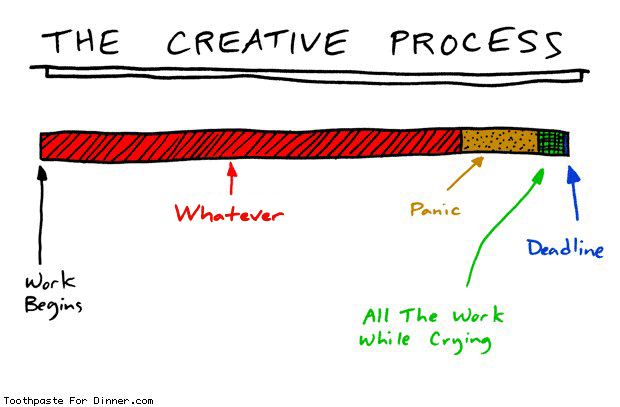
I have a friend I play ball hockey with who is a printer often doing work for tradeshows. We talked frequently about the booth but I didn’t have a solid plan until May (for many reasons).
I asked the printer how long it would take to do our backdrops, floor, etc. I worked with my designer and sent him the files one at a time to the printer, as they were signed off by me. I asked how the printer wanted them, he said PDF. My designer said the PDF files would be huge and since they were rasterized images anyway he’d just give me big jpgs. I sent the first file to the printer asking if it was ok.
For some unexplainable, mind-boggling reason, the printer sat on the files for over a week before opening them and telling me they were all wrong. They needed crop marks and bleeds, etc. I jumped back to my designer and he tried to set it up the way requested but it was still wrong. Finally, the printer said he would just get his guy to set up the files correctly rather than the back and forth.
This delay and back and forth cost 2 weeks. The printer said we were still ok. He emailed me a production schedule for all the elements from various places in the US.
I looked at it and said “This is all fine, but it comes down to the shipping. If the shipping to Portland is 2 days we’re fine. If it’s 5 days then we’re screwed.”
His exact answer was “No, it’s all 2 day shipping by default.”
I said “Ok!” and moved on to other things.
It was 5 day shipping.
The printer couldn’t get us our backdrop until the last day of the show. He couldn’t speed up the production or the shipping, so he got someone else to print a rush order and overnighted a giant tube from Toronto to Portland with the backdrops. I don’t know what it cost him to do this but it was significant. Had he looked at the files when I sent them none of it would have been necessary.
I can’t stress this enough to me, for you: give yourself a one-week buffer for the inevitable screw-ups.
Since all this drama happened at the mini-Con GenCon went perfectly smooth.
Other benefits of having a pilot Con:
Was able to track exactly how long it took to setup and tear down the booth.
This was important for GenCon because they have specific dock times I had to work around, and I needed to know and plan my arrivals accordingly.
Tested the layout of the booth.
We tried multiple configurations before settling on one that worked
Tested the demo on real live people
We discovered our tutorial sucked, important buttons weren’t clear they were buttons, and several demo stopping bugs we missed. With 3 weeks between cons we had enough time to spruce up the demo and have something polished to show.
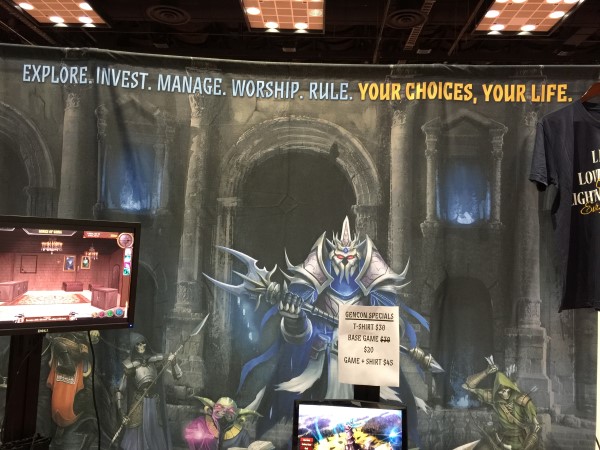
The backgrounds are either the first or second thing the customer sees as they approach the booth, so they are pretty important. Since we had a corner booth we only needed two “walls” which are 8’ high. To make it more inviting I made the right wall 2’ shorter so it was easier to walk into the booth from that lane of approach.
The custom backgrounds signal that we are serious and shows the artwork. Our art style signals familiarity to role-players, especially Pathfinder players. This is because Rogier works for Paizo on Pathfinder and for us on Archmage Rises. I was able to leverage that in almost every conversation and people really liked knowing the artist worked on both. Sometimes it was an ice-breaker where the customer would mention how much they liked the artwork.
The verbs along the top allowed the customer to educate themselves. When my wife came to help (she knows nothing about the game, not from lack of me telling her!) she could just read and point at the words along the top. I was shocked when she was able to close some pre-orders!
For comparison, I looked at this 9’ backdrop for $991
Cost: 8’ $600 + 10’ $655 = $1,255

The custom floor immediately signals we are different than every other game booth and gives an “other world” vibe to the booth. Only us and the big guys had a custom floor.
Printed on four 4’x4’ 3mil plastic sheets the floor looks great, is super durable. It’s actually designed for dance floors at weddings (who woulda known!)
Cost: $680
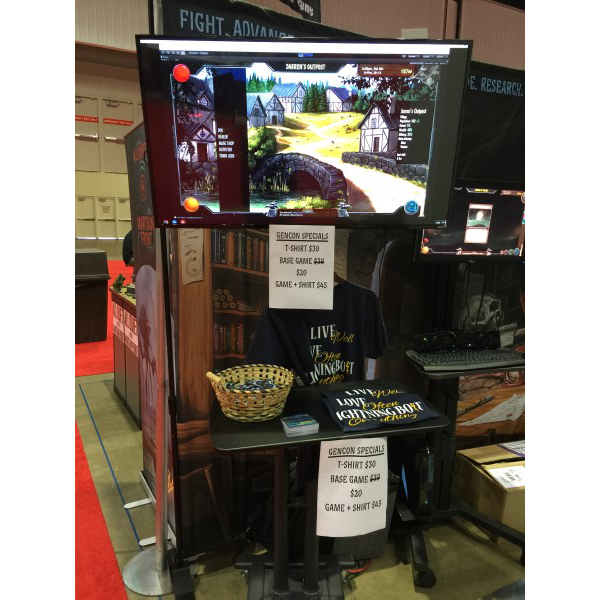
People are afraid to enter your booth and try your demo. Bizarre but true.
A TV screen running a video safely lets someone engage with your booth without entering. It also catches people’s interest (especially at a tabletop Con where many of the presenters don’t have screens).
A video signals professionalism. After all, only “expensive things” are on TV! :-)
The shelf below the TV was the perfect place to store business cards of the game. Many people who didn’t pre-order asked for a card as a reminder, and this was a great place to keep them. We also put buttons on the shelf which people walking by helped themselves to.
I created the video myself. I recently made a pitch to a major publisher and so used segments of that presentation as the base for the video. I cut each segment of me talking about the game, or design, or features to about 5 minutes. That is how long I wanted someone to engage with watching and then be freed up to talk with us or move on. I then interspersed the demo/talking parts with time lapsed speed paints by Rogier the artist. It took me 4.5 hours to make the video and was a big hit.
Rogier painting at high speed is interesting to watch (visit his youtube channel). Sometimes the group in front of the TV would exceed 6 or more. And almost to a person, they would always wait to see the picture complete, so we “captured” them for about 4 minutes and had a perfect opportunity to pitch them. More than one person asked “What is this, a painting program for RPGs?”
The demo with me talking wasn’t as effective at making passersby stick as the speed painting, but it was quite useful. When the combat portion was up, I could incorporate it into my pitch. When the hex map showing monster lairs and how the world simulates their movements and attacks on the population, I could incorporate that into my presentation.
The painting was pretty, but the demo was useful.
The biggest challenge you will face in showing a video is: How do you get it to loop! None of the native video players on tablet, or apple tv/roku, or even Chrome OS will loop.
I read on indieboothcraft how devs would have to manually keep restarting the video on a tablet or such. What a nightmare, I certainly didn’t want to be a “restart monkey” for 9 hours a day.
My solution was to buy a Chromebit. There is a free app called VLC that provides video looping. Even better the chromebit has local storage, so once you can copy on your video file and run totally offline with nothing that can break.
I got a Bluetooth combo keyboard/mouse, like what you would use for a raspberry pi or a phone. It works great and is so small I can tuck it behind the TV when not needed.
The only thing I would change about the video is updating it to the latest game graphics. So much of the game improved the week before the Con (including UI) that the video was out of date by the time we hit the Con. Oops.
Costs:
42” TV $300
Stand $294
Chromebit $99
Bluetooth keyboard/mouse $30
Nothing signals that your game is real and of quality like a demo they can walk up and play.
I was really inspired by what TinyBuild has in their booth. Not only can 4 people play but the locking cabinet below provides security and hides away little necessities like more business cards or shirt stock.
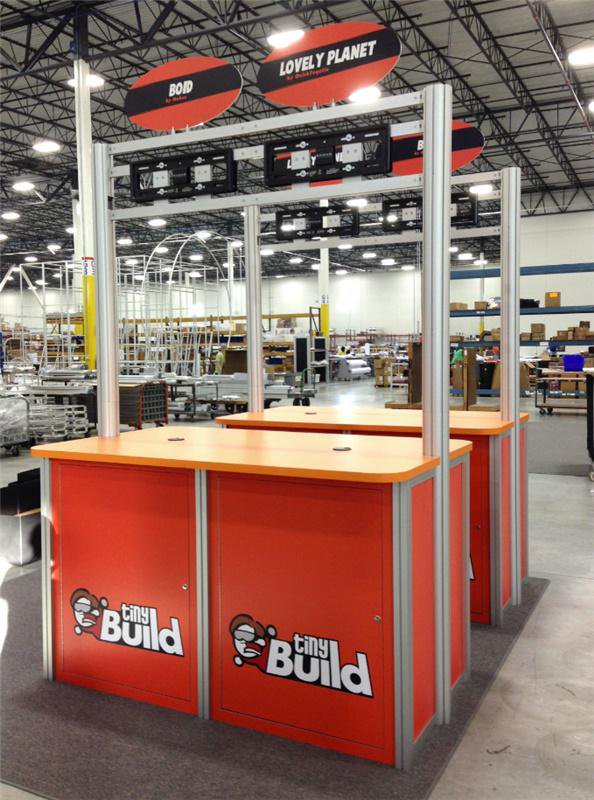
I worked with 2 different tradeshow companies and the quotes were coming in between $7,000-8,000 to have that. I’m willing to invest in my game, but that that is just too much for only one piece of the booth.
The second thing I realized was a player station like that makes sense in an island booth, but not a corner booth. There isn’t enough room to maneuver around it.
Finally, I just went with these stand up work stations from Displays2Go. At only $310 a piece they are not only extremely affordable, but extremely flexible. If using only laptops, the side cpu holder comes right off. The monitor height is totally adjustable. They even have powerbars built into the back!
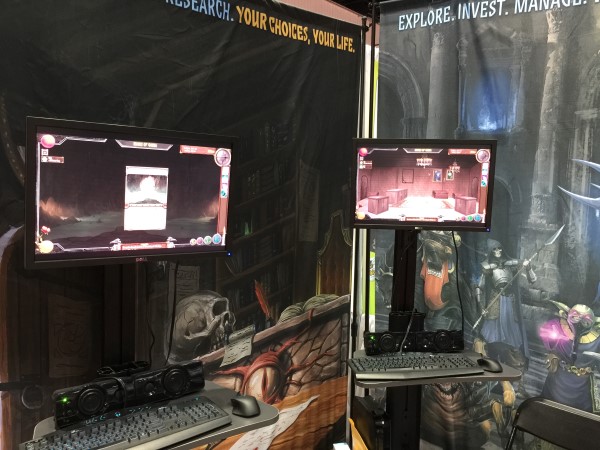
The player stations are on wheels so can be moved into a variety of configurations even during the Con. At home I can use them for other purposes instead of just taking up space in my garage. So these stands were a total win.
For computer equipment, I have a partnership with Alienware who lets me use any equipment I need for shows from their pool. Good company, very helpful to indies.
Cost: $310 x 3 = $930
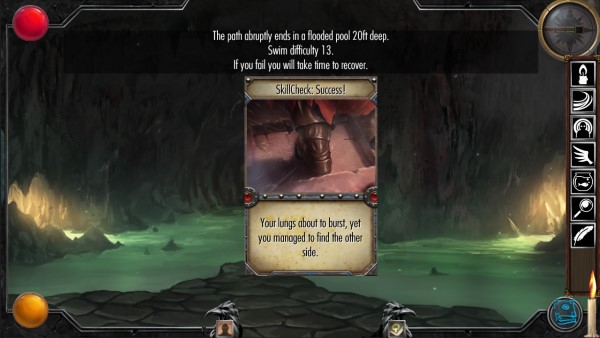
Archmage Rises is a difficult game to demo at a Con. A lot of the “fun” happens between the player’s ears. It is also a sandbox game where the player makes their own emergent stories and goals. So if they want to build and finance an orphanage to rescue all the orphans in the land, finding an orphan in a village is super exciting. But to someone who just walked up it’s just a bunch of text and some menus.
A mistake I have experienced as a player at a Con is having a demo without a tight specific goal that can be achieved in a short period of time. The goal is not for the player to experience the first hour, but to have a small delicious taste in a few minutes. Like the tasting spoons at Ben & Jerry’s ice cream shop.
We designed a very specific goal for the player: Have a noble give/sell them land to build a mage tower. This could be accomplished in completing two dungeons, about 10 minutes. If you die, then you’d be done sooner. And like the arcade machines of old, we leaned it towards killing so people would get off the machine and let someone else have a try.
Well no matter what the intro said, or the tutorial, no one followed the demo path. No one won and few even tried to win. It was more tire kicking and exploring than playing. Maybe that is best for an open world game.
Everyone seemed to gravitate towards talking with the procedurally generated NPCs. I’m not entirely certain why this is, maybe because our conversation system is unlike any other game? Or they are so trained by other games that you have to explore every “branch” that is what they immediately started doing?
Our demo was buggy because it was a rush job. We finished it 2am the night before the Con. Fortunately, we left all the dev keys turned on allowing us to exit out of the game, restart, and jump to specific features. Nic was able to fix the most egregious errors that first night, and the demo ran better the following 3 days.
Finally, I had a really clever idea that totally failed.
If people were going to be playing the game, why not capture some metrics and their email address? So I created (well, actually I got a fan to help me) a demo launcher that sorta ran the computer in kiosk mode and would launch then monitor the game process. This way we could see how long someone played the game, and upon exit (death or win) it would ask them for a rating from 1-10 and their email if they would like to sign up to the newsletter.
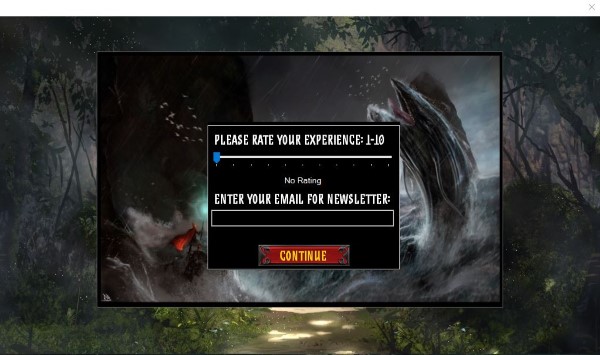
Most of the players never made it far enough to win or die. They would poke around, and then walk away to pre-order or leave. There were no valuable metrics. We would have to restart the game manually. So the launcher was essentially a waste of effort.
After all the work that went into planning out the demo stations and building the specific demo, only 10% of people tried it. Most were content to just watch someone else play. Or to have me drive and explain features as I went.
Ironically, the demo stations were really valuable for pitching. When I would ask for the close, sometimes the objection would be “Well, I’d like to see combat first.” I would walk up to an open demo station, hit ‘e’ (a dev shortcut) and immediately pop into battle. Then I could explain the tactical turn based combat. I’d do two rounds, and this was enough for them to be satisfied and pre-order.

The TV and the Photo Op are two easy ways to interact with the booth outside of talking or demo playing. It is the first or second thing the attendee sees.
Putting one’s face into the hole of the Archmage is symbolically what the player does in the game. It is YOU playing, not you playing a character.
The best thing about the photo op is how it made people stop and dare their friends into it. This creates a mini-crowd which causes others to take notice and it just snowballs from there.
It was also a hands off way for people to interact with the game and get a souvenir that says “Archmage Rises” right on it.
Based on my printer’s suggestion, I printed a vinyl banner and used the same mounting hardware as the backdrops to hang it. This became a problem as the minimum width of the poles was 42” while the banner was only 24”. That’s a lot of wasted space in a tiny booth and creates a barrier between us and the attendees walking by. If I were to do it again, I would print it on cardboard and have it stand up on its own from the base. Other booths did this for their photo op and it was better.
I don’t know how many people took their photo in it. Maybe 200? It wasn’t too many the first 2 days, but the last two days it seemed to ramp up quite a bit. Sometimes Nic and I would be asked to move so people could take their photo. I’d call that a success!
The only bad thing is the hole for the face is too small. It makes everyone look ridiculous. This isn’t all bad, as it made people laugh and dare each other to put their face in. I think we got more photos taken because it was funny than if it was serious.
The reason our head size is too small is how I measured. I knew the piece of artwork I wanted to use, I measured my face from forehead to chin and told the designer to scale the picture to make the faces match. Well that’s the wrong way to do it. I should have measured my whole head and made sure the pictures whole head matched. We ended up with a head 25% smaller than the person’s head, leading to the hilarity of putting your face in it.
Cost: $300
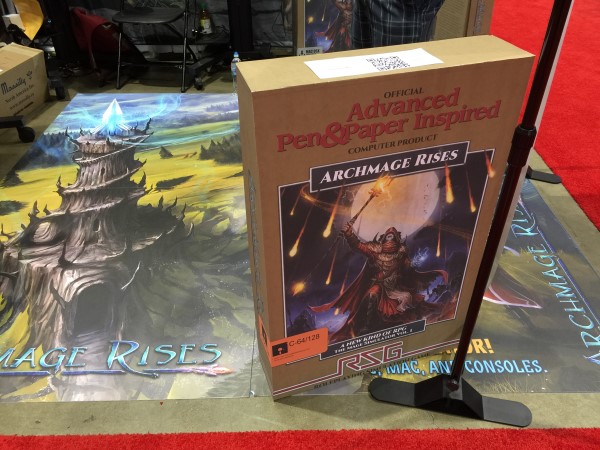
Archmage Rises has the old school vibe of the SSI games from the 90’s, put into a modern RPG. What better way to signal this to my core audience than with a giant oversized gold box edition!
I got the idea from Blendo Games and how they had little boxes strung up under their TV. If little boxes are cool, giant boxes would be cooler!
For months I talked with my printer about how to make a box 24x36x6”. He just couldn’t do it.
I went to print on demand board game places asking for anyone who could make me a box that size or close to it. They all said no.
One night, frustrated about something else, I tried searching for it again. I found Print & Play. I did a hail-Mary by using their contact form to ask if they could do it. They said they weren’t sure and would ask the owner. The thought really creatively and finally figured out a way to do it! Even better, they were 15 minutes from the mini-Con, so no shipping cost! Hallelujah!
The boxes were epic wins. By far the best thing we did in the booth. People immediately came up to engage in conversation. When they pre-ordered some admitted, “You had me at the gold box”. :-)
This is a great example of how the right prop can do a lot of the work signaling the customer for you.
Because I was printing three (IBM, Mac, and C64) the boxes were discounted to $178 each.
From what I hear, the company enjoyed the challenge of making them. They even showed them at their open house the weekend before bringing them to the mini-Con.
Cost: Gold Boxes 3x178 = $534
In reading indieboothcraft.com I came across Ryan Creighton’s article on Spellirium. Ironically, he’s a friend who lives just an hour away. In selling his game at PAX 2013 he had the clever idea of putting his steam key inside a small potion-y vial. I love how thematically appropriate it is and the physicality of handing over a “something” instead of just a sticker.
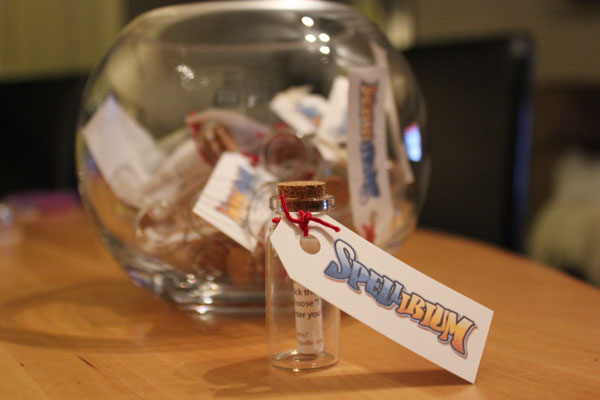
I went through a lot of ideas. I wanted the “thing” to be something good and useful. To signal lasting quality.
My initial idea was to make a notebook with a cover that looked like a D&D spellbook. To get anything of quality the unit costs were getting close to $10. Way way too high.
Amidst the flurry of activity during the week before GenCon I asked my wife to take this item off my plate: go to a dollar store and get something wizard-y, spell-y. Just something around $3 or less.
Then an idea hit me: what about a (unpainted) Reaper mini? I remember we sold them in my game store for $4 a piece. It would be nice and big. Role players use reaper minis to play so it is immediately familiar and valuable. My other idea was a d20. Those are super valuable, but too small for a sticker to be applied nicely.
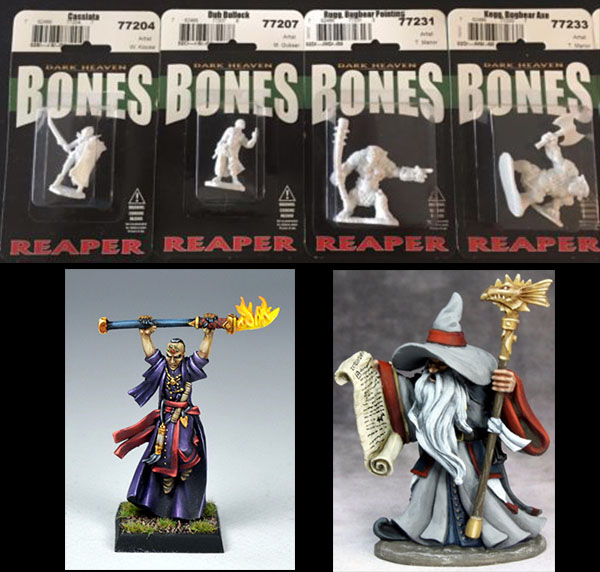
I asked my supplier if I could get like 100 reaper minis shipped to me in a few days, just an assortment of wizards, sorcerers, druids, clerics, casting adventurers. They said no, for that kind of volume I’d have to go reaper direct. So I did. I was able to pick out 19 minis x5 each for a total of 95 minis.
I had no idea how many pre-orders I would sell, this seemed like more than enough. Last thing I need is more unpainted minis to bring home (I already own thousands).
Well, as identified in the section about closing, the mini was one of the best decisions I made.
We sold through the 95 by the second day. I had to find a vendor that sold reaper minis and he gave me a discount to buy 30 more.
Then I sold those.
So I bought 15 more.
Then I sold those.
In the last few hours I just put steam keys on business cards and handed those out. So mission accomplished, I didn’t take any miniatures home!
Cost: Miniatures $3 x 140 = $420

Another touchpoint with the customer, a physical piece of swag signals preparation and professionalism.
Nic suggested we have buttons as swag, saying it was common at game Cons to put them on one’s backpack. I’ve never done that but figured it was a good idea and ordered some small ones (1.25”).
Well the buttons were a huge hit in many ways. First, it was a super ice-breaker. If the booth was empty, I’d grab the basket and just approach people as they walked by, “Would you like a button?” They would say yes, and then ask what Archmage Rises was. That’s worth its weight in gold!
Also noted above, it allowed me to work the line in front of the booth in a generous way.
We were handing out buttons like crazy the first two days, then we realized we would run out so we got more picky about them. I only had 1,000 buttons, for a Con this size, I could have easily given away 1,000 a day.
Even when the baskets of buttons were put aside, people would walk up and ask for one. I remember one lady picked one up, looked at me, and asked “Can I have one?”
“Sure, their $20.”
She looked at the button hard. What I loved was how she paused to think if she really would pay $20 for the button.
I told her they were free, she was relieved, and took it. :-)
Cost: Buttons 1.25” Round 0.17 x 1,000 = $170
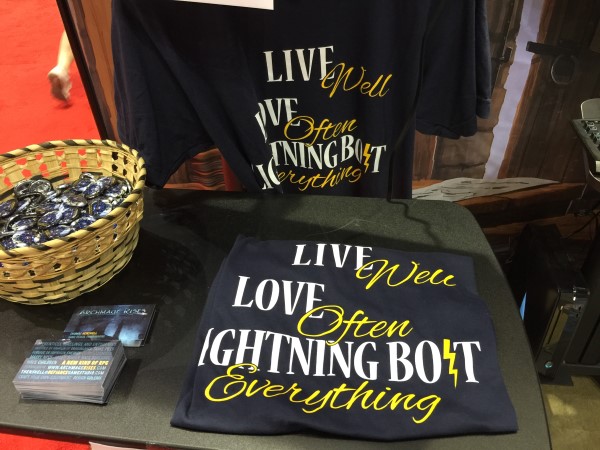
A shirt with your game on it signals you are a professional and the game is legit. It also makes it clear who is working the booth and who is just visiting.
I wanted a shirt that would last. Not just a logo, but something cool on it that people could get behind, and I would still want to wear in 5 years.
It took a lot of iterations and I floated some designs out to the fanbase to see what resonated with them. They chose this:
I like it because what the shirt says is one way to play the game. It is cohesive, not just a random funny saying.
Due to print times, I got a rush job done at a photo transfer place in California. Personally, I can’t stand how every gaming shirt is always black. Black makes my programmer-white skin look especially pasty. We decided to print them on grey for $33 a piece, total $66.
They arrived and the print quality was really low. The letter’s color was muted and just didn’t have the impact I was hoping for. We wore them, for the mini-Con but it needed to be fixed.
I asked the printer for better shirts with louder popping colors. He recommended we go with American Apparel which is the same company U2 uses. Happy that now, finally, I would be just like Bono, I went with that. To get the unit cost down I ordered 50 shirts. The extras are for sale at the show, or future shows, or part of the pre-order specials on the website. Knowing my target audience, most of them are men XL and XXL.
With a lot of drama the second set of shirts arrived at my hotel at GenCon the day before the show. They look good, I’m really happy with them.
The shirts cost me $21 a piece so I decided the most I could sell them for $30, which is hardly enough to make it worth all the effort and outlay of cash. I made a GenCon special where the customer could get the game and the shirt for $45, saving $5 off the shirt.
The shirts were a financial flop at the show.
We only sold 3 shirt + game packages and had one stolen (through an error on our part).
One girl bought just the shirt. Her friend told us why: in a D&D session she shot off chain lightning and almost TPK’d the entire party. So “Lightning Bolt Everything” is “so her”. I like that story because it shows the shirt is resonating with the core customer base.
In hindsight I think we sold less shirts simply because I didn’t bring much attention to them. I was spending so much time pitching the game, and closing with the miniature, it seemed awkward to then say “would you like the shirt too?”
That is another way to close, called the Either/Or close. Instead of making the choice “would you like to pre-order OR not” make it “Would you like to pre-order with the shirt or without?” It is very effective and allows the customer a choice: pay the higher or lower amount. For some reason not paying is off the table. :-)
Cost:
Initial shirts $33 x 2 = $66
Better shirts $21 x 50 = $1,050
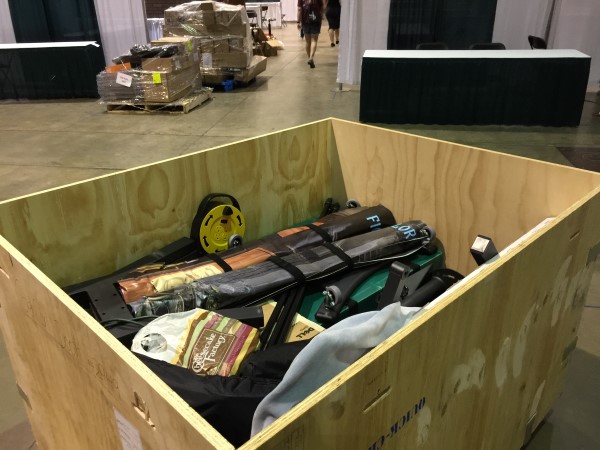
So I got all this stuff for the booth: floor, backdrops, tv, demo stations. How do I move it around? I don’t live close to either show and can’t drive from Portland to Indy. I have to ship it. All the single individual boxes will cost a ton to ship by courier, so I need some way of sticking it all together and shipping by freight.
The professionals use stuff like this: 47x35x18 plastic crate for $735
Trouble is, I’ll need at least two of those for all my stuff. My two biggest challenges are the floor at 44x44” a piece followed by the goldboxes at 36x24x6”. With 3 of them, that is 36x24x18”!
Then I found QuickCrate. Simple reusable 46x46x31 wooden crates for $237!
I wanted wheels on the bottom of mine so I can push it around without a pump truck or forklift (the crate itself weighs 300lbs). Well if you want wheels that’s a custom order and the price jumps to $640. Sucky, but still way way cheaper than any other option I could find.
The crate is the best logistical thing I did. I double checked the volume of the crate and all the things I had ordered online (remember, I wouldn’t see anything until I arrived in Portland at the mini-Con). It all fit.
After the mini-Con we decided to throw all the demo computers and monitors inside the crate too, saving me from shipping them back to Alienware and them having to ship them to GenCon. Even with the extra stuff everything still fit. Well, it was a bit of a tetris puzzle for an hour, but we finally got it all inside!
Cost: Shipping Crate $640
I don’t know if other Cons have this as an option. At GenCon there is a booth outside the main doors running Con-Quest. Players get a quest card, visit the booths listed on it to get a special punch, then return it complete to be entered into a draw for prizes. Alienware generously donated a steam machine on our behalf for the draw. It’s a neat way to drive traffic to a booth. I felt since we were so far off to the side of the convention center I might as well do it.
It is impossible for me to know how many people came to our booth questing because I was so busy with other people. When I noticed them patiently waiting I’d punch their card, then continue with whomever I was with.
Several of the questers would stick around and ask what Archmage Rises was, and some pre-ordered. Sometimes there would be 4 of them lined up, which would peak other’s interest and get them to stroll over and check us out. So it certainly worked.
There were SO many people at GenCon one could scarcely walk the aisles to go to the bathroom. I’m not convinced the traffic boost was needed.
Cost: Sponsorship $385
Backdrops $1,255
Floor $680
TV, stand, Chromebit $723
Demo Stations $930
Photo Op $300
Buttons $170
Shirts $1,110
Goldbox $534
Miniatures $420
Crate $640
Con-Quest $385
Total: $7,147
$2,700 Corner booth
$400 for power
$500 shipping of crate
$500 handling, storage of the crate
$2,000 hotel 2 rooms for 5 nights
$350 flight for Nic
$150 in gas
$350 Food and such
Total: $6,950
Total Cost: $14,097
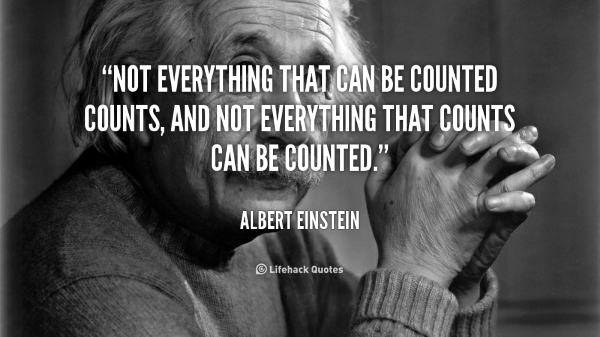
Entrepeneuers should be familiar with the above quote. Accountants and taxmen look only at the numbers. Entrepreneurs have a higher calling: to look beyond the numbers to see the whole picture.
In business we use strategy to determine success or failure of initiatives. Strategy determines goals, actions are then judged against those goals. What is the goal of the Lean Start-Up? Validated learning. If you don’t have a specific or concrete goal, you will never know if you missed or hit it.
So what was my goal?
My goal in attending GenCon was a marketing one: to make a splash, get word out to an audience that would understand and receive it. Pre-order sales are one concrete way of getting word out (someone who plays the pre-alpha could recommend the game to a friend), but a secondary objective. We took pre-orders because it seemed silly to hype someone up about the game and not capitalize on it.
We took 145 pre-orders and sold some shirts for total revenue of $3,090.
Revenue is only one of the benefits of our attendance. These are the other ones:
More than anything else, we got confirmation we are on the right track. To the target audience of hardcore table top role-players, the game is appealing and people who “get it” absolutely love it. This is a big win for the design and the team. One pre-order person said “This is why I come to GenCon, to meet indie game developers that are doing something fresh!” This is validated learning. No pivot required.
I’m convinced Cons are the way to market this game. I need to get the game out to more cons both before and after release. I didn’t know this before I went. I’ve already paid for the booth and own everything. So now it’s just shipping, travel, and hotel to show the game elsewhere. This is validated learning and a pivot in marketing strategy is required.
We’ve planted a ton of seeds that will bear fruit over the coming months and perhaps years. 1,000 buttons, 500 cards, ~1,000 one-on-one presentations.
We’ve created a nucleus of Mavens (or Net Promoters) that are now sharing Archmage Rises with their friends. One person who pre-ordered came back and told me he sent the website to 12 people in his gaming group back home. Some others came back and bought additional copies for their friends/family. This critical core is what we need to continue to build our fan base. This is common for GenCon attendees: back home are the people who couldn’t go waiting to hear what their friend discovered.
We now have an active steam community dialoging with us about the game, this didn’t exist before GenCon.
We had a video interview by BoardGameGeek.com. Podcast interview, met several youtube streamers with subscribers in thousands and tens of thousands, that will do previews of the game.
Talking with some of the pre-order people revealed new ideas we can easily implement that will add good value to the game.
Well, I didn’t know I spent that much over the last 8 months until I started writing this conclusion and had to add it up. As I sit here and ponder the cost, it ultimately has to come down to comparing results against goals.
I share the numbers with you so you know all the details as you make your plans for your game.
For me, the answer is yes. It was worth it.
Read more about:
Featured BlogsYou May Also Like